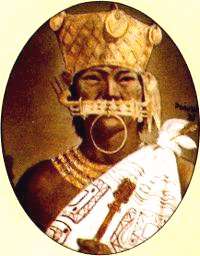Timeline of Bogotá
The following is a timeline of the history of the city of Bogotá, Colombia.
This is a dynamic list and may never be able to satisfy particular standards for completeness. You can help by expanding it with reliably sourced entries.
Prehistory
See also: Muisca Confederation § Prehistory
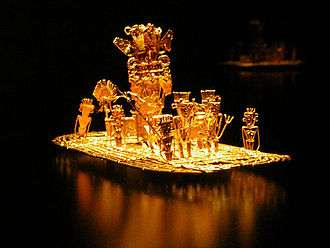 |
| Muisca |
|---|
| Topics |
| Geography |
| The Salt People |
| Main neighbours |
| History & timeline |
- The area around Bogotá was inhabited since the late Pleistocene, with sites El Abra (12,500 BP), Aguazuque and Tequendama as earliest evidences of inhabitation
(† 1537)
The flat Bogotá savanna is clearly visible in the topography of the Altiplano Cundiboyacense. The flatlands are the fertile bottom of a Pleistocene lake that existed until around 30,000 years BP. The last zipa of the Muisca, ruling over the Bogotá savanna, was Tisquesusa, who was killed by one of the soldiers of the conquest expedition, opening up the reign of the Spanish over the terrain and the foundation of Bogotá
Pre-conquest
See also: Muisca Confederation and Spanish conquest of the Muisca
- <1537 - Bogotá and its surroundings was called Bacatá by the Muisca who inhabited the Bogotá savanna and were organised in their loose Muisca Confederation
16th century
See also: New Kingdom of Granada
- 1538 - Santa Fe de Bogotá founded by Spanish conquistador Gonzalo Jiménez de Quesada.[1]
- 1539 - 27 April: Municipal council in session[2]
- 1540 - City status granted by Charles I of the Spanish Empire[2]
- 1549 - City becomes capital of the New Kingdom of Granada
- 1550 - Santo Domingo convent founded.
- 1553 - Main Plaza relocated[3]
- 1557 - Santo Domingo convent relocated
- 1558 - Smallpox epidemic
- 1561 - Roman Catholic Diocese of Santafé en Nueva Granada established[2]
- 1564 - Archbishop Juan de los Barrios gifts his house for the establishment of the San Pedro hospital
- 1565 - Chapel built[4]
- 1578 - The enterpreuner and landowner Francisco Hernán Sanchéz, urbanizes the surrounding areas to the river and builds a temple
- 1580 - Saint Thomas Aquinas University founded
- 1592 - San Bartolomé Seminar School founded[3]
17th century

Map of Bogotá and surrounding valleys
1650
1650
- 1604 - Jesuit college established
- 1616 - Population: 3,000[2]
- 1621
- 1635 - Iglesia de San Ignacio (church) opens[4]
- 1653 - Our Lady of the Rosary University founded
- 1674 - Santa Clara church built[4]
- 1675 - Leprosy epidemic
- 1681 - Typhus epidemic
- 1692 - Measles epidemic
18th century
Panoramic view of Bogotá
1772
1772
- 1714 - Earthquake
- 1717 - City becomes capital of the Viceroyalty of New Granada
- 1739 - The San Pedro hospital is renamed as the San Juan de Dios hospital
- 1777 - Real Biblioteca Publica (library) founded[5]
- 1781 - The rebellion of the Comuneros (commoners in English) takes place
- 1782 - José Antonio Galán and other leaders of the Comuneros are hanged in the Plaza Mayor de Santafé
- 1783 - La Enseñanza school founded[3]
- 1785 - Earthquake[4]
- 1789 - Population: 18,161
- 1791
- First map of the city is made by Domingo Esquiaqui
- Papel periódico de la Ciudad de Santa Fe de Bogota newspaper begins publication[6]
19th century
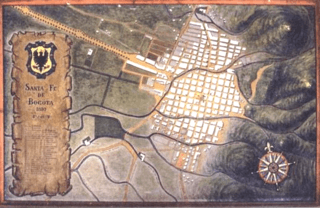
Map of Bogotá
1810
1810

Map of Bogotá
1857
1857
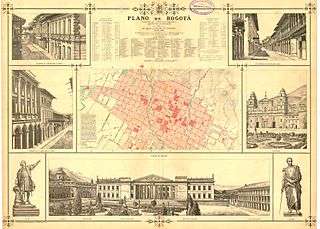
Map of Bogotá
1890
1890
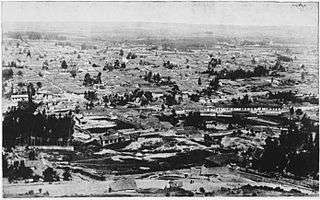
Overview of Bogotá
1893
1893
- 1801 - Population: 21,394[2]
- 1803 - Observatorio Astronómico constructed[7]
- 1810 - City becomes capital of the Free and Independent State of Cundinamarca
- 1816
- Spaniard Pablo Morillo in power[1]
- Puerta Falsa cafe in business
- 1819
- Santafé de Bogotá is renamed as Bogotá
- Population: 30,000
- 1823 - Primary Cathedral built
- 1824 - Colombian National Museum opens
- 1836 - Central Cemetery of Bogotá established
- 1840
- Trolleybus starts operating
- El Día newspaper begins publication[8]
- 1846
- 1847 - Society of Artisans organized[11]
- 1864 - Medicine & Natural Sciences Society founded
- 1865 - Telegraph begins operating[12]
- 1867 - Universidad Nacional de Colombia (national university) is founded
- 1870 - Banco de Bogota founded[10]
- 1871 - Academia Colombiana de la Lengua (national language academy) founded
- 1875 - Capitol building constructed[1]
- 1876 - Prison begins operating.[13]
- 1881 - Papel Periódico Ilustrado begins publication[14]
- 1884
- Compañía Colombiana de Teléfonos (telephone company) established
- Tramway begins operating[4]
- 1886 - Universidad Externado de Colombia and Escuela de Bellas Artes (school)[15] founded
- 1887 - The aqueduct is upgraded to an iron aqueduct pipe
- 1889
- Facatativá-Bogota railway begins operating
- Bogotá Electric Light Company is founded
- 1890 - Bavaria brewery in business[16]
- 1891 - The Medicine & Sciences Society is renamed as Academia de Medicina (Colombia), (Medicine Academy)
- 1892
- Usaquen train station of the Ferrocarril del Norte (Bogotá) inaugurated
- Teatro de Cristóbal Colón inaugurated
- 1893
- 1895
- Municipal Theatre inaugurated
- Population: 95,813[2]
- 1896 - The glass factory Fenicia established
- 1898
- Hipodromo de la Gran Sabana (racecourse) inaugurated
- Revista Ilustrada begins publication
20th century
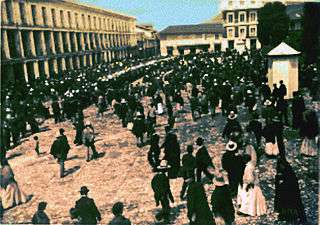
Plaza Bolívar
1900
1900

Statue of Christopher Columbus, inaugurated in 1906
1920s
1920s
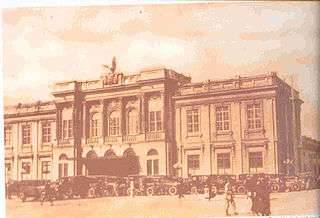
Central train station
1930
1930

El Dorado Airport
1940s
1940s
Part of a series on the |
||||||||||||||||||||
|---|---|---|---|---|---|---|---|---|---|---|---|---|---|---|---|---|---|---|---|---|
| History of Colombia | ||||||||||||||||||||
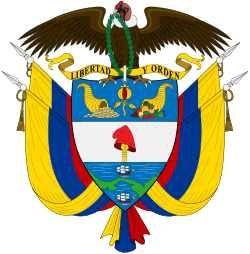 | ||||||||||||||||||||
| Timeline | ||||||||||||||||||||
|
||||||||||||||||||||
|
| ||||||||||||||||||||
- 1900 - 31 July: Coup[2]
- 1902
- Academia Colombiana de Historia (history academy) founded
- The Edificio de Lievano (city hall) set
- 1905 - Population: 100.000
- 1908 - Palacio de Nariño dedicated
- 1909
- Compañia de Cementos Samper (cement company) established
- Electric streetcar begins operating[2]
- 1910
- Exposición del Centenario de la independencia (world's fair) held
- Javier Tobar Ahumada becomes mayor
- 1911
- First airplane lands in Bogotá for an exhibition
- El Tiempo newspaper begins publication
- 1912
- 1915 - El Espectador newspaper begins publication in Bogota
- 1918
- Population: 143.994
- Flu epidemic
- 1921 - First student strike
- 1922 - Quinta de Bolívar museum inaugurated
- 1923 - Police headquarters building constructed[4]
- 1926 - Capitolio Nacional built
- 1928
- Bogotá Stock Exchange established
- Population: 235,421[2]
- 1929 - Medellín-Bogota railway begins operating[12]
- 1930
- Aerodromo del Techo (aerodrome) is built[18]
- The Voz de la Victor (radio) founded
- 1931 - Santamaría Bullring constructed
- 1933 - First Juegos Atléticos Nacionales takes place
- 1936 - El Siglo newspaper begins publication
- 1937 - University City (campus) of National University of Colombia built
- 1938
- Estadio El Campín, Alfonso López Pumarejo Stadium, and National Library building constructed[19]
- 400th anniversary of city founding[20]
- Avenida de Las Américas (avenue) built
- Population: 336,996[2]
- First Feria Internacional del Libro de Bogotá (book fair) inaugurated
- 1939 - Gold Museum established
- 1941 - Corporación Deportiva Santa Fe (football club) formed
- 1946 - Millonarios Fútbol Club formed[21]
- 1947 - Architect Le Corbusier is hired to conduct the city planning
- 1948
- March–April: International Conference of American States held[22]
- 9 April: Bogotazo
- District University of Bogotá and University of the Andes established
- 1951 - Population: 715.250
- 1952 - City flag design adopted[3]
- 1953 - Bogotá Museum of Modern Art inaugurated
- 1954
- Bosa, Engativa, Fontibon, Suba, Usme, and Usaquen townships become part of city[2]
- First television transmmission is made
- Colombian Film Archive founded[23]
- La Republica newspaper begins publication[6]
- Mass migration from other regions in Colombia to Bogotá, due to violence since the Bogotazo
- Corferias (Fair and Exposition Corporation of Bogotá) founded
- 1955 - Bogotá Botanical Garden opens[24]
- 1956 - University of America founded
- 1958
- Construction of the 26th Avenue begins
- Luis Ángel Arango Library opens[25]
- 1959
- El Dorado Airport in operation
- Corficolombiana headquartered in Bogota
- 1960 - Population: 1,271,700[2]
- 1961 - John F. Kennedy visits Bogotá
- 1963 - Puente Aranda becomes part of the city
- 1964
- Population: 1'697.311
- Charles de Gaulle visits Bogotá
- 1965 - El Espacio newspaper begins publication[6]
- 1967 - Bogotá Philharmonic founded
- 1968
- August: Pope Paul VI visits the city
- Simón Bolívar Park inaugurated
- Fuerza Aérea de Colombia (national airforce) establishes the Aeronautical Museum in the old airport of Techo
- 1969 - Avianca Building constructed
- 1970
- Catholic University of Colombia founded
- Population: 2,526,000[2]
- 1974 - Ciclovía inaugurated[26]
- 1976 - First shopping center in the city, Unicentro (Bogotá) opens
- 1977 - Centro de Comercio Internacional built
- 1978 - Torre Colpatria built
- 1979 - Leftist guerrilla M-19 takes the embassy of Dominican Republic
- 1982 - Military University Nueva Granada established
- 1984
- Bus terminal inaugurated
- Metrópolis shopping center inaugurated
- Bogotá Film Festival begins[27]
- 1985
- 6 November: Palace of Justice siege
- Population: 3,983,000[2]
- 1986
- 3 July: Pope John Paul II visits the city
- Children's Museum of Bogotá established
- 1987 - Housing complex Ciudad Salitre construction begins
- 1988
- Andrés Pastrana Arango first mayor of Bogotá elected by popular vote, previously they were elected by the president or governor
- Iberoamerican Theater Festival held
- 1989
- Archivo General de la Nación (government department) inaugurated
- 6 December: Bombing in Paloquemao
- Santa Barbara shopping center opens
1990s
- 1990 - La Equidad football club formed
- 1991 - Juan Martín Caicedo Ferrer becomes mayor
- 1992 - Sonia Durán de Infante becomes mayor, succeeded by Jaime Castro Castro[28]
- 1993
- Population: 5'484.244
- November: Bombing on 15th Avenue
- 1995
- Rock al Parque music festival begins
- Antanas Mockus Sivickas becomes mayor
- Centro Andino shopping mall opens
- September: Track Cycling World Championships held at Luis Carlos Galán Velodrome
- 1996
- Casa de Moneda de Colombia (museum) inaugurated
- Paul Bromberg Silverstein becomes mayor
- 1998
- Maloka Museum of science inaugurated
- Enrique Peñalosa Londoño becomes mayor
- 1999
- Citytv Bogotá begins broadcasting
- Mormon temple dedicated
21st century

View from Torre Colpatria
2006
2006

Hotel Tequendama at night
2013
2013
Panoramic view of Bogotá
2016
2016
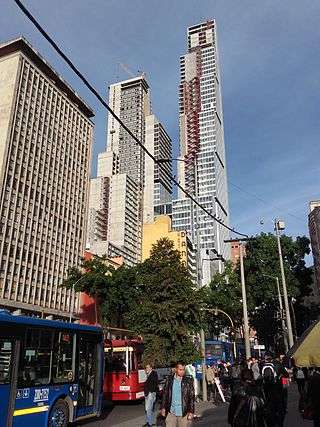
BD Bacatá
August 29, 2016
August 29, 2016
2000s
- 2000
- TransMilenio bus system begins operating
- 24 February: Car-Free Day inaugurated
- 2001
- Colombian Securities Exchange headquartered in city
- Antanas Mockus Sivickas becomes mayor
- July: Copa América football tournament held at El Campín Stadium[29]
- 2002
- 25 January: Bombing
- 7 August: Attack at Presidential Palace
- 13 December: Hotel bombing
- 2003
- National Symphony Orchestra of Colombia founded
- 7 February: El Nogal Club bombing
- 8 October: Bombing
- 15 November: Attack in pub
- 2004
- Luis Eduardo Garzón becomes mayor
- 29 October: Bombing
- 2005
- Bogotá's Carnival resurrected
- Population: 6,778,691
- 2006
- Bike Paths Network laid out
- Centro Comercial Santafé shopping mall opens
- 31 July: Bombing
- 2008
- La Peluquería (art space) founded[30]
- Samuel Moreno Rojas becomes mayor
- 2009 - Fundación Capital headquartered in city[31]
2010s
- 2011 - María Fernanda Campo becomes mayor, succeeded by Clara López Obregón
- 2012 - Gustavo Petro becomes mayor[32]
- 2013
- Google Street View begins operating
- December: Pro-Petro demonstration[33]
- 2014 - Population: 7,776,845 (urban agglomeration).[34]
See also
- History of Bogotá
- List of mayors of Bogotá
- Metropolitan Area of Bogotá
- List of universities in Bogotá
- Timeline of Colombian history
- Other cities in Colombia
References
- 1 2 3 Britannica 1910.
- 1 2 3 4 5 6 7 8 9 10 11 12 13 14 15 Marley 2005.
- 1 2 3 4 "About Bogota". Bogota: District Institute of Tourism. Retrieved 10 March 2013.
- 1 2 3 4 5 6 7 "Bogota". Colombia. Lonely Planet. Retrieved 10 March 2013.
- ↑ Edwin S. Gleaves; Uriel Lozano Rivera (1994). "Colombia". In Wayne A. Wiegand and Donald G. Davis, Jr. Encyclopedia of Library History.
- 1 2 3 "Bogota D.C." (in Spanish). Universidad Distrital Francisco José de Caldas. Retrieved 10 March 2013.
- ↑ Ibáñez 1891.
- ↑ "Bogotá (Colombia) Newspapers". WorldCat. USA: Online Computer Library Center. Retrieved 10 March 2013.
- ↑ Egberto Bermúdez (2008). "From Colombian national song to Colombian song: 1860-1960". Lied und populäre Kultur / Song and Popular Culture. 53.
- 1 2 Sowell 1993.
- ↑ David Sowell (1987). "'La teoria i la realidad': The Democratic Society of Artisans of Bogota, 1847-1854". Hispanic American Historical Review. 67.
- 1 2 Jonathan C. Brown (1980). "The Genteel Tradition of Nineteenth Century Colombian Culture". The Americas. Academy of American Franciscan History. 36.
- ↑ Mitchel P. Roth (2006). "Chronology". Prisons and Prison Systems: A Global Encyclopedia. Greenwood. ISBN 978-0-313-32856-5.
- ↑ "Hemeroteca Digital Histórica" [Historical Digital Newspaper Library] (in Spanish). Bogota: Biblioteca Luis Ángel Arango del Banco de la República. Retrieved 10 March 2013.
- ↑ International Center for the Arts of the Americas. "Documents of 20th-century Latin American and Latino Art". Museum of Fine Arts, Houston. Retrieved February 28, 2015.
- ↑ Phanor James Eder (1913), Colombia, London: T.F. Unwin, OCLC 1719625
- 1 2 Sowell 1989.
- 1 2 Historia Techo
- ↑ Reid 1939.
- ↑ Coester 1938.
- ↑ Tom Dunmore (2011). Historical Dictionary of Soccer. Scarecrow Press. ISBN 978-0-8108-7188-5.
- ↑ "Bogota", Webster's Geographical Dictionary, Springfield, Massachusetts: G. & C. Merriam Co., 1960, p. 140, OL 5812502M
- ↑ "Historia de la Fundación Patrimonio Fílmico Colombiano" (in Spanish). Retrieved 10 March 2013.
- ↑ "Garden Search: Colombia". London: Botanic Gardens Conservation International. Retrieved December 30, 2015.
- ↑ Terence S. Tarr (1970). "The Organization of the Royal Public Library of Santa Fe De Bogota". Journal of Library History. 5.
- ↑ "Bogotá's Ciclovia could teach Boris Johnson how to run a car-free capital". The Guardian. UK. 16 June 2010. Retrieved 10 March 2013.
- ↑ "Historia" (in Spanish). Festival de Cine de Bogota. Retrieved 10 March 2013.
- ↑ Rhinehart 2009.
- ↑ "History". Copa America 2011. Retrieved 10 March 2013.
- ↑ "Colombia". Art Spaces Directory. New York: New Museum. Retrieved 2 December 2013.
- ↑ "Organizations in Bogota D.C., Colombia". USA: Idealist.org. Retrieved May 30, 2015.
- ↑ "Colombian mayors and local government". City Mayors.com. London: City Mayors Foundation. Retrieved 27 April 2013.
- ↑ "Mayor Ousted in Colombia After Claims of Bungling", New York Times, 9 December 2013
- ↑ "Population of Capital Cities and Cities of 100,000 or More Inhabitants". Demographic Yearbook 2014. United Nations Statistics Division.
This article incorporates information from the Spanish language Wikipedia
Bibliography
in English
- Published in the 19th century
- Abraham Rees (1819), "Bogota", The Cyclopaedia, London: Longman, Hurst, Rees, Orme & Brown
- Gaspard Théodore Mollien (1824), "(Santa-Fe de Bogotá)", Travels in the Republic of Colombia, London: C. Knight, OCLC 4373721
- William Duane (1826), "(Bogotá)", A Visit to Colombia, in the Years 1822 & 1823, Philadelphia: T. H. Palmer
- Josiah Conder (1830), "Bogotá", The Modern Traveller, London: J.Duncan
- John Steuart (1838). Bogotá in 1836-7: Being a Narrative of an Expedition to the Capital of New Granada. New York: Harper & Brothers.
- Isaac F. Holton (1857), "Bogota", New Granada: Twenty Months in the Andes, New York: Harper & Brothers, OCLC 2422862
- George Henry Townsend (1867), "Santa Fe de Bogota", A Manual of Dates (2nd ed.), London: Frederick Warne & Co.
- Erastus Wilson (1878), "Santa Fe de Bogota", A Ramble in New Granada, New York: G.W. Carleton & Co., OCLC 15516568
- Rosa Carnegie Williams (1881), A Year in the Andes; or, A Lady's Adventures in Bogotá, London: London Literary Society, OCLC 1720050
- "Santa Fe de Bogotá". Harper's New Monthly Magazine. 1885.
- "Bogotá". Commercial Directory of Latin America. Washington DC: Bureau of the American Republics. 1892.
- "City of Santa Fe de Bogotá". Commercial Directory of the American Republics. Washington DC. 1897.
- Published in the 20th century
- "Bogota", Chambers's Encyclopaedia, London: W. & R. Chambers, 1901
- "Bogota", Encyclopaedia Britannica (11th ed.), New York, 1910, OCLC 14782424 – via Internet Archive
- V. Levine (1914). Colombia. South American Handbooks. New York: D. Appleton & Co.
- William Alfred Hirst (1915), "Bogotá", Guide to South America, New York: Macmillan Company
- Alfred Coester (1938). "Santa Fe de Bogotá". Hispania. 21. doi:10.2307/332672.
- John T. Reid (1939). "Cultural Bogotá". World Affairs. 102.
- David Sowell (1989). "The 1893 Bogotazo: Artisans and Public Violence in Late Nineteenth-Century Bogota". Journal of Latin American Studies. 21.
- Geoff Crowther; et al. (1990), "Bogota", South America (4th ed.), Lonely Planet, p. 461+, OL 8314412M
- David Sowell (1993). "La Caja de Ahorros de Bogotá, 1846-1865: Artisans, Credit, Development, and Savings in Early National Colombia". Hispanic American Historical Review. 73.
- Rakesh Mohan (1994), Understanding the Developing Metropolis: Lessons from the City Study of Bogotá and Cali, Colombia (2nd ed.), Oxford University Press / World Bank, ISBN 9780195208825
- Published in the 21st century
- "Bogota". Understanding Slums: Case Studies for the Global Report 2003. United Nations Human Settlements Programme and University College London. 2003.
- David Marley (2005), "Bogota", Historic Cities of the Americas, Santa Barbara, Calif: ABC-CLIO, ISBN 1576070271
- Politics and Security in Three Colombian Cities, London: Crisis States Research Centre, 2009 – via International Relations and Security Network (about Bogota, Cali, Medellin)
- Nancy Rhinehart (2009). "Public Spaces in Bogotá: An Introduction". University of Miami Inter-American Law Review. 40.
- Zeiderman, A., 2013. 'Living Dangerously: Biopolitics and urban citizenship in Bogotá, Colombia', American Ethnologist 40(1):71-87.
in Spanish
- Charles Wiener (1884), "Bogotá", América pintoresca (in Spanish), Barcelona: Montaner y Simon
- Pedro M. Ibáñez (1891), Las crónicas de Bogotá y de sus inmediaciones (in Spanish), Bogotá: Impr. de la Luz, OCLC 2205470
- José Toribio Medina (1904). La imprenta en Bogotá (1739-1821) (in Spanish). Santiago de Chile: Imprenta Elzeviriana – via HathiTrust. (Annotated list of titles published in Bogotá, arranged chronologically)
- Germán Rodrigo Mejía Pavony (2000). Los años del cambio: historia urbana de Bogotá, 1820-1910 (in Spanish) (2nd ed.). Pontificia Universidad Javeriana.
- Natalia León Soler (2008), "Bogotá: de paso por la capital", Revista Credencial Historia (in Spanish) (224) (includes timeline)
External links
| Wikimedia Commons has media related to Bogotá. |
- Items related to Bogotá, various dates (via Digital Public Library of America)
- Items related to Bogotá, various dates (via Europeana)
Coordinates: 4°35′53″N 74°04′33″W / 4.598056°N 74.075833°W
This article is issued from Wikipedia - version of the 11/28/2016. The text is available under the Creative Commons Attribution/Share Alike but additional terms may apply for the media files.

